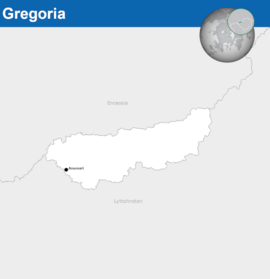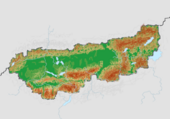Gregoria: Difference between revisions
No edit summary |
No edit summary |
||
| Line 145: | Line 145: | ||
The Evardom has a population of around 6.4 million people<ref>[https://imgur.com/a/K5FI5lU "2020 Gregorian Population Census"] - Carried out by the government of Gregoria</ref>. The population is fairly sparsly urbanised, with a population density of around x/km2 (x/sq mi). | The Evardom has a population of around 6.4 million people<ref>[https://imgur.com/a/K5FI5lU "2020 Gregorian Population Census"] - Carried out by the government of Gregoria</ref>. The population is fairly sparsly urbanised, with a population density of around x/km2 (x/sq mi). | ||
Gregoria is a {{wp|constitutional monarchy}}<ref>[https://imgur.com/a/K5FI5lU "Controversies with the Gregorian Monarchy" - International Centre for Human Rights </ref>, with the [[Evar of Gregoria]] acting as the Head of State and the Prime-Minister as the Head of Government. The [[House of Delegates]] is the local legislature, able to pass bills on devolved matters with permission from the Evar. The House of Delegates hold legislative power. Gregoria has a neutral foreign policy<ref>[https://imgur.com/a/K5FI5lU "Gregoria's Neutrality" (2013) - Andrew D. Coffman</ref> , and has since the [[Great War (Anteria)|Great War]], this means the nation is not a member of any international organisations outside of the [[Assembled Nations]]<ref>"The exception to Gregoria and her neutrality is with the AN, with whom they share good relations</ref>. Despite this, they have positive relations with the [[Thrismari Union]] as well as nations such as [[Encessia]]<ref>[https://imgur.com/a/K5FI5lU "History of Encessia-Gregorian Relations" (1999) The Gazette. Retrieved May 15 2022.</ref> and [[Prymalia]]. | Gregoria is a {{wp|constitutional monarchy}}<ref>[https://imgur.com/a/K5FI5lU] "Controversies with the Gregorian Monarchy" - International Centre for Human Rights </ref>, with the [[Evar of Gregoria]] acting as the Head of State and the Prime-Minister as the Head of Government. The [[House of Delegates]] is the local legislature, able to pass bills on devolved matters with permission from the Evar. The House of Delegates hold legislative power. Gregoria has a neutral foreign policy<ref>[https://imgur.com/a/K5FI5lU "Gregoria's Neutrality"] (2013) - Andrew D. Coffman</ref> , and has since the [[Great War (Anteria)|Great War]], this means the nation is not a member of any international organisations outside of the [[Assembled Nations]]<ref>"The exception to Gregoria and her neutrality is with the AN, with whom they share good relations</ref>. Despite this, they have positive relations with the [[Thrismari Union]] as well as nations such as [[Encessia]]<ref>[https://imgur.com/a/K5FI5lU "History of Encessia-Gregorian Relations"](1999) The Gazette. Retrieved May 15 2022.</ref> and [[Prymalia]]. | ||
Revision as of 15:28, 15 May 2022
Evardom of Gregoria გრიგორიის ევარდომი (Gregorian) | |
|---|---|
| Anthem: "გრიგორიანის ეროვნული ჰიმნი" (Gregorian) "Gregorian National Anthem" | |
 Gregoria's Location in Thrismari. | |
 | |
| Capital | Ananuri |
| Largest | Ananuri |
| Official languages | Gregorian |
| Ethnic groups | |
| Demonym(s) | Gregorian |
| Government | Unitary parliamentary constitutional monarchy |
• Evar | Alexei IV |
• Prime-Minister | Kira Kobalia |
• Evarwifia | Eva Alavidze |
| Legislature | House of Delegates |
| Population | |
• 2022 estimate | 6,440,000 |
• 2020 census | 6,432,332 |
Gregoria (Gregorian:გრიგორიის ევარდომი [2]) officially the Evardom of Gregoria is a country in west-central Thrismari, landlocked and surrounded by Encessia to the north and Lyttohnstan to the south. The nation is located exclusively within the Narinjinsperi Mountain Range, giving the nation a rough but naturally beautiful climate. Gregoria has a total land area of x km^2[3], making it one of the smallest countries in continental Thrismari.
The Evardom has a population of around 6.4 million people[4]. The population is fairly sparsly urbanised, with a population density of around x/km2 (x/sq mi).
Gregoria is a constitutional monarchy[5], with the Evar of Gregoria acting as the Head of State and the Prime-Minister as the Head of Government. The House of Delegates is the local legislature, able to pass bills on devolved matters with permission from the Evar. The House of Delegates hold legislative power. Gregoria has a neutral foreign policy[6] , and has since the Great War, this means the nation is not a member of any international organisations outside of the Assembled Nations[7]. Despite this, they have positive relations with the Thrismari Union as well as nations such as Encessia[8] and Prymalia.
Etymology
The name 'Gregoria' derives from the patron saint of Gregoria, Saint Gregory, who founded the nation and established the beginning of recorded history within the mountain enclave. It became the name of the nation in 1566, however, replacing Tsilori[9] due to a legal documentation signed by the Evar that gave the land the name 'Gregoria' which is believed to be for the ease of Common speakers. Despite this, the name in the native language remains as Tsilori, to present day.
History
Archaeological evidence suggests that prehistoric humans related to Thrismarian Aborigines inhabited Gregoria from 8000 BCE. Wall paintings and small pieces of pottery were left behind in the Gregorian Narinjinsperi, near Mount Gori, which were traced to the early Medeaic People. The pottery was dated back to around 5,400BCE. At some point in the 5th millennium BCE, the earliest descendants of the Proto-Gregorian and Osseten people arrived from Encessia, known as the Sarinpuji People. These people began to spread across the entire nation. By the end of the 4th millennium BCE, they were believed to have been the dominant political ethnic group. These early people lived in thatched and straw mud yurts and huts, which were easy to construct as well as sturdy and strong. The people were believed to be advanced for their time, storing their harvest in granaries, and creating a system of roads running between settlements of great houses. By 1,400BCE city-states began to be established however never constituted one political unity, but instead likely shared cultural identity based on a common language. Each major city-state was ruled by a head monarch.
Politics
Geography
Gregoria is located in the southern regions of the Narinjinsperi Mountain Range that stretch from southern Encessia into central Lyttohnstan. The mountains surround Gregoria, giving it an alpine climate. Gregoria encompasses a great diversity of landscapes and climates on a limited area of xkm^2 (x square miles). The nations population is around 6.4 million people (2021 estimate). Gregoria has an estimated population density of x people per km2 (x/sq mi). In the largest canton, Tskhami, the population density falls to around 13 people per km2.
The nation lies entirely within the -2 timezone, on the same latitude as nations such as Alamtar and Aisharia and the same longitude as nations such as the Ganji Islands and Foxomexra. It contains three basic topographical areas: the Gregorian Narinjinsperi to the south, the Gregorian Plateau or Western Plateau, and the Sera mountains on the east. The Narinjinsperis are a high mountain range running across the north, west, south and some of the east of the country, constituting about 70% of the country's total area. The large majority of the nations citizens live in the Gregorian Plateau region. Among the high valleys of the Gregorian Narinjinsperi, many glaciers are found, totalling an area of 806 square kilometres (311 sq mi). From these originate the headwaters of several major rivers, such as the Gortanula, Inna, Pzilrua and Rhône, which flow in the four cardinal directions into the whole of Thrismari and into the Marmor Sea.
Thirty-seven of Gregoria's mountain peaks are 4,000 metres (13,000 ft) above sea in altitude or higher. At around 4,539m (14,891 ft), Mount Gori is the tallest of these peaks and is located in the eastern mountainous regions, known as the Gregorian Narinjinsperi. It's the same region that a majority of the nations mountain peaks are located. The section of the Narazeni Narinjinsperi above the deep glacial Ananuri valley, containing 72 waterfalls, is well known for the Sagvichio (3,998m) and the many picturesque valleys in the region.
The more populous northern part of the country, constituting about 80% of the country's total population, is called the Gregorian Plateau. It has greater open and hilly landscapes, partly forested, partly open pastures, usually with grazing herds or vegetables and fruit fields, but it is still hilly. There are large lakes found here, and the biggest Gregorian cities are in this area of the country.
Climate

Government and Military
Economy
Culture
Architecture and Arts
Media
Music
Cuisine
Ski Culture
Sports
See Also
Notes
References
- ↑ "Analysis of Gregorian Census Data" - 2020 Study.
- ↑ "Complexities of the Gregorian Language" - William Hardwell White
- ↑ "Countries in Anteria by Area" - Geographical Press
- ↑ "2020 Gregorian Population Census" - Carried out by the government of Gregoria
- ↑ [1] "Controversies with the Gregorian Monarchy" - International Centre for Human Rights
- ↑ "Gregoria's Neutrality" (2013) - Andrew D. Coffman
- ↑ "The exception to Gregoria and her neutrality is with the AN, with whom they share good relations
- ↑ "History of Encessia-Gregorian Relations"(1999) The Gazette. Retrieved May 15 2022.
- ↑ "Facts and Trivia on Tsilori" - Retrieved 15 May 2022



